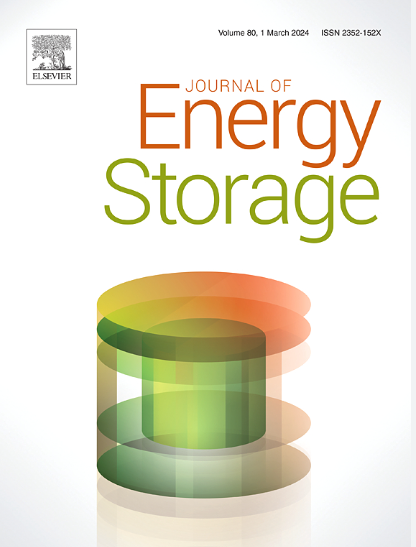Recyclable cellulose-based vitrimer electrolytes for lithium ion batteries
IF 8.9
2区 工程技术
Q1 ENERGY & FUELS
引用次数: 0
Abstract
Cellulose as polymer electrolytes in lithium-ion batteries (LIBs) has a number of advantages such as low cost, readily available, abundant, environmentally friendly, and contains electron-donating groups within its structure. Beside, vitrimers are a novel class of polymer materials made of dynamic covalent networks that can undergo bond-exchange processes. Beyond cellulose's special qualities, cellulose-based vitrimer production is highly desired for enhancing electrolytes mechanical qualities, thermal stability, cyclability, and ionic conductivity. In this study, cellulose-based vitrimeric polymer electrolytes are prepared. At first, poly(glycidyl methacrylate-co-methyl acrylate) by different ratios of comonomers is prepared and then cellulose is cross-linked by prepared copolymers. Prepared vitrimers are recycled four steps through transesterification reaction and as-prepared and recycled crosslinked celluloses are used as gel polymer electrolytes (GPEs). The results showed the best ionic conductivity of as-prepared samples in order of 10−4 S/cm whereas ionic conductivity increased to order of 10−3 S/cm for recycled samples. Also, high lithium-ion transfer number of >0.8 was achieved for recycled samples. All as-prepared and recycled electrolytes had excellent electrochemical stability window (> 5 V). Also, improved specific capacity (>178 mA h g−1 with capacity retention upper than 90 % after 200 cycles at 0.2C of LiCoO2/GPEs/Gr) was attained.
用于锂离子电池的可回收纤维素基三聚氰胺电解质
纤维素作为锂离子电池(LIB)的聚合物电解质具有成本低、易于获得、资源丰富、环保以及结构中含有电子捐献基团等诸多优点。此外,玻璃聚合物是一类由动态共价网络组成的新型聚合物材料,可以进行键交换过程。除了纤维素的特殊品质外,纤维素基玻璃聚合物的生产在提高电解质的机械品质、热稳定性、可循环性和离子导电性方面也有很高的需求。本研究制备了纤维素基三聚体聚合物电解质。首先用不同比例的共聚单体制备聚(甲基丙烯酸缩水甘油酯-丙烯酸甲酯),然后用制备的共聚物交联纤维素。通过酯交换反应将制备好的三聚体循环使用四个步骤,然后将制备好的纤维素和循环交联的纤维素用作凝胶聚合物电解质(GPE)。结果表明,原样制备的样品离子传导性最好,约为 10-4 S/cm,而回收样品的离子传导性则提高到 10-3 S/cm。此外,回收样品的锂离子转移数高达 0.8。所有制备的和回收的电解质都具有出色的电化学稳定性窗口(5 V)。此外,还提高了比容量(>178 mA h g-1,钴酸锂/GPEs/Gr 在 0.2C 下循环 200 次后容量保持率高于 90%)。
本文章由计算机程序翻译,如有差异,请以英文原文为准。
求助全文
约1分钟内获得全文
求助全文
来源期刊

Journal of energy storage
Energy-Renewable Energy, Sustainability and the Environment
CiteScore
11.80
自引率
24.50%
发文量
2262
审稿时长
69 days
期刊介绍:
Journal of energy storage focusses on all aspects of energy storage, in particular systems integration, electric grid integration, modelling and analysis, novel energy storage technologies, sizing and management strategies, business models for operation of storage systems and energy storage developments worldwide.
 求助内容:
求助内容: 应助结果提醒方式:
应助结果提醒方式:


